SAP Cloud Platform - Quick Guide
SAP Cloud Platform - Introduction
SAP Cloud Platform is a cloud service provided by SAP based on platform as a service (PaaS) to develop and deploy custom web applications. SAP is responsible for managing complete infrastructure of this platform including hardware servers, maintenance cost, component upgrades, and system lifecycle.
SAP Cloud service provides full range of service catalog including database, storage and data backup, reporting service and transaction layer to develop multi-platform software development. SAP Cloud platform customers can utilize this cloud environment for managing software development or can also use a hybrid model based on cloud and on premise environment.
SAP Cloud platform can be integrated with following to get data and development −
- SAP Applications
- 3rd party applications
- Internal solutions
Note that the above mentioned can be on premise or on cloud and can be easily integrated with SAP Cloud platform for application development.

SAP Cloud platform supports business critical solutions for software development and it includes −
- SAP Fieldglass
- SAP Success factors
- SAP Hybris
- SAP Ariba
- BusinessObjects
- SAP ERP Business suite
- Concur
You can migrate apps and extensions seamlessly to SAP Cloud platform including SAP Business suite and SAP S/4 HANA. All the data centers are managed by SAP itself, so you can expect the given key benefits associated with data center management −
- Security
- Compliance
- Availability
Why SAP Cloud Platform is Different?
SAP Cloud platform offers PaaS based in-memory and microservice based mobile enabled cloud applications. SAP Cloud Platform provides you an option to control your choice of clouds, frameworks, and applications.
To know more about SAP Cloud platform and services offered by Cloud service, you can navigate to this link − https://cloudplatform.sap.com/index.html
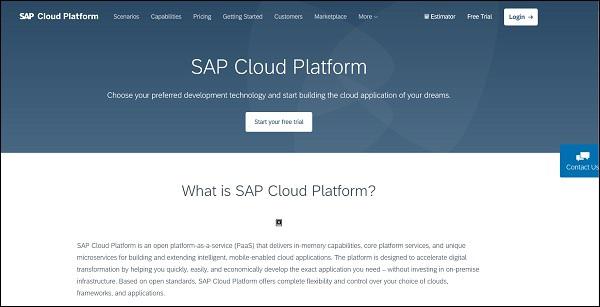
SAP Cloud Platform - Free Trial
SAP Cloud platform also provides a free trial. For creating a trial account, you need to click “Start your free trial” button as shown below. You can also chat with SAP experts for any queries.
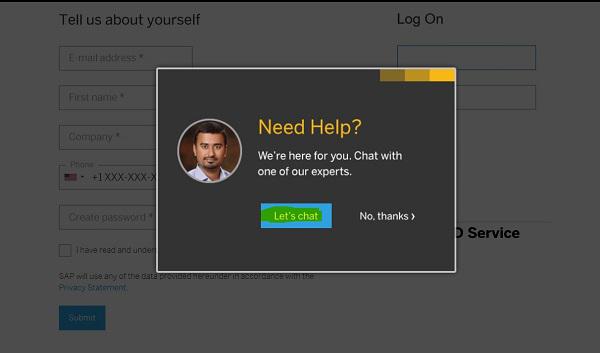
To register for free trail, you need to provide your work email id, and other details. Once you successfully submit all the details, you can use that for logging into the Cloud service.

Once you provide all details and login, you will get a message − “Welcome to your free trial”. To start your trial, click the blue icon - “Click here to start your trial”. SAP also assigns you a unique User Id for your trial period.
Once you login, it takes you to SAP Cloud platform cockpit.
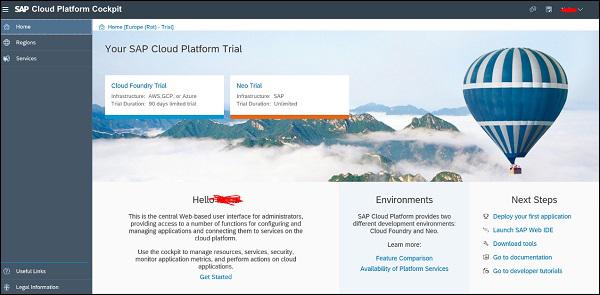
SAP Cloud Platform cockpit is the central Web-based user interface for administrators, and you can use this for providing access to various functions for configuring and managing applications using SAP Cloud platform. You can use the cockpit to manage resources, services, security, monitor application metrics, and perform actions on cloud applications.
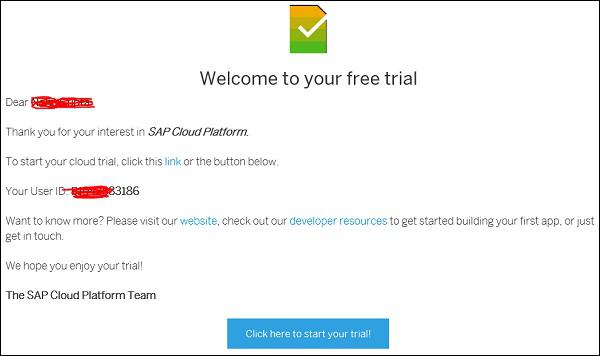
SAP Cloud Platform - Service Description
The service level agreement for SAP Cloud service is applicable to Cloud service mentioned in service description guide. You can check detail on Service level agreement using this link −1 https://cloudplatform.sap.com/support/service-description.html
The System Availability SLA for all Cloud Services is 99.9% per month. Any deviations from the 99.9% System Availability SLA or any aspect of the standard Service Level Agreement for SAP Cloud Services are noted in the applicable Cloud Service terms in this Service Description Guide.
You can check the details using this link − https://www.sap.com/about/agreements/cloud-services.html
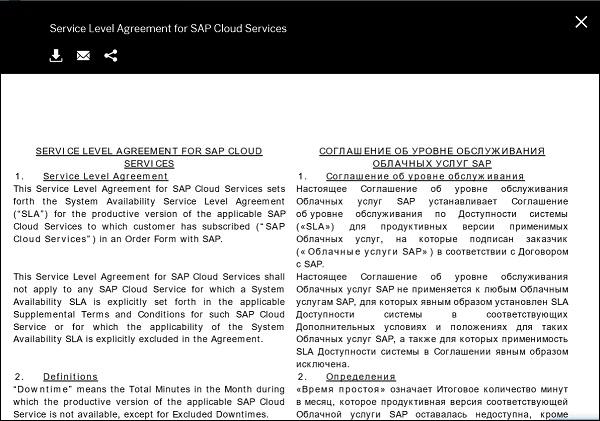
High Availability
As per SAP - High Availability option for HANA and ASE Service in SAP’s data centers, SAP shall provide High Availability for SAP Cloud Platform, HANA service or SAP Cloud Platform ASE service with an availability SLA of 99.95% per month if Customer has allocated to High Availability via SAP Cloud Platform provisioning self-service a duplicate of SAP Cloud Platform, HANA service or SAP Cloud Platform ASE service, as applicable. The duplicate SAP Cloud Platform services allocated to High Availability require separate subscriptions (and associated fees). In all other respects, the Service Level Agreement for SAP Cloud Services referenced in the Order Form applies to the applicable SAP Cloud Platform services.
| SAP Cloud Platform Java server |
| Cloud Service Description |
Java server means a virtualized hardware resource used by Java-based Platform Applications. |
| Usage Metric |
Monthly Flat Fee per Piece |
| Explanation of Usage Metric |
Flat Fee means fixed monthly subscription fees |
| Piece Size |
1 Java server = 1 Piece |
| Available T-Shirt Sizes: |
| Size |
x-small |
small |
medium |
large |
| Cores |
1 |
2 |
4 |
8 |
| Memory (MB) |
2,048 |
4,096 |
8,192 |
16,384 |
|
| Service Availability “SLA” |
Precondition to System Availability SLA −
|
| Previously referred to as |
SAP HANA Cloud Platform, Java server (x-small) = SAP HANA Cloud Platform, compute unit lite
SAP HANA Cloud Platform, Java server (small) = SAP HANA Cloud Platform, compute professional
SAP HANA Cloud Platform, Java server (medium) = SAP HANA Cloud Platform, compute premium
SAP HANA Cloud Platform, Java server (large) = SAP HANA Cloud Platform, compute premium plus |
| SAP Cloud Platform Virtual Machine |
| Cloud Service Description |
SAP Cloud Platform Virtual Machine is a virtualized infrastructure-as-a-service hardware resource used to host and run SAP or third-party applications. |
| Usage Metric |
Monthly Flat Fee per Piece |
| Explanation of Usage Metric |
Flat Fee means fixed monthly subscription fees per Piece |
| Piece Size |
1 virtual machine server = 1 Piece |
| Available T-Shirt Sizes |
| Size |
x-small |
Small |
medium |
large |
x-large |
| Cores |
1 |
2 |
4 |
8 |
16 |
| Storage (GB) |
20 |
40 |
80 |
160 |
320 |
| Memory (MB) |
2,048 |
4,096 |
8,192 |
16,384 |
32,768 |
|
| Additional Terms |
Customer may use the Cloud Service to host and run separately licensed SAP or third-party applications. Customer is solely responsible for the security, maintenance, management and support of the applications installed by Customer on the Cloud Service. Customer is responsible for back up of Customer Data – no back up services are included in the Cloud Service. The Cloud Service is provided through a single data center. As such, no redundant data center is included for disaster recovery services. Customer is solely responsible for managing and updating the OS layer of the Cloud Service, including patching the OS with the most recent security patches made available by the OS vendor.
Customer shall fully compensate SAP (without effect of any limitations on liability in the GTCs) for any damages or expenses incurred by SAP as a result of a claim by a third party that any Customer or third-party software or other technology hosted or run on the Customer’s Cloud Service virtual machine infringes or otherwise violates the rights of the third party.
|
| SAP Cloud Platform Portal |
| Cloud Service Description |
SAP Cloud Platform Portal is a flexible environment that allows Customer to create and extend business websites. |
| Usage Metric |
Per User per month |
| Explanation of Usage Metric |
A User is an individual authorized to access Customer’s SAP Cloud Platform Portal. |
| Pre-requisite |
At least one (1) SAP Cloud Platform portal administrator |
| Additional Terms |
SAP Cloud Platform Portal is limited to access by individuals within the Customer’s organization, including employees and contractors. Each SAP Cloud Platform Portal subscription also includes −
|
| Previously referred as |
SAP HANA Cloud Platform, portal service SAP HANA Cloud Portal |
| SAP Cloud Platform SAP HANA server (<size>, BYOL) |
| Cloud Service Description |
Fully provisioned environment for Customer to bring separately purchased SAP HANA license to develop, test and run Platform Applications. |
| Usage Metric |
Monthly Flat Fee per Piece |
| Explanation of Usage Metric |
Flat fee means fixed monthly subscription fees |
| Piece Size |
1 Piece = 1 instance of a particular T-shirt size |
| Available T-Shirt Sizes |
| Size |
64 GB |
128 GB |
256 GB |
512 GB |
1 TB |
| Cores |
12 Cores |
24 Cores |
32 Cores |
40 Cores |
80 Cores |
| HANA Memory |
64 GB |
128 GB |
256 GB |
512 GB |
1 TB |
| Disk Space |
640 GB |
1280 GB |
2560 GB |
5120 GB |
10 TB |
| bandwidth(out) |
512 GB /Month |
1 TB /Month |
|
| Additional Terms & Conditions |
SAP Cloud Platform SAP HANA Server (BYOL) does not include a license to the SAP HANA database or any other database. Customer must have a valid license agreement for the SAP HANA database in order subscribe to SAP Cloud Platform SAP HANA Server (BYOL). Customer may not use SAP Cloud Platform SAP HANA Server (BYOL) or copy, access or use the SAP HANA database software accessible through the SAP HANA HANA server (BYOL) without such current license. Any attempt to access the SAP HANA database without such a license is a violation of SAP’s intellectual property rights and a breach of this Agreement for which Customer will be fully liable to SAP. Customer’s use of the SAP HANA database is governed by the license agreement under which it is licensed to Customer and support for the SAP HANA database is provided under applicable support agreement, if any. No support for the SAP HANA database accessible through SAP HANA Server (BYOL) provided under this Agreement.
|
| Previously referred to as |
SAP HANA Cloud Platform, SAP HANA server SAP HANA Infrastructure Services |
| SAP Cloud Platform SAP HANA service (SAP DC), standard edition |
| Cloud Service Description |
SAP Cloud Platform SAP HANA service (SAP DC), standard edition allows Customer to develop, test and run Platform Applications– with a fully provisioned HANA environment including subscription-based SAP HANA database standard edition instance. |
| Usage Metric |
Monthly Flat Fee per Piece |
| Explanation of Usage Metric |
Flat fee means fixed monthly subscription fees |
| Piece Size |
1 Piece = 1 instance of a particular T-Shirt size |
| Available T-Shirt sizes in Neo environment |
| Size |
32 GB |
64 GB |
128 GB |
256 GB |
512 GB |
1 TB |
| Cores |
8 Cores |
12 Cores |
24 Cores |
32 Cores |
40 Cores |
80 Cores |
| HANA Memory |
32 GB |
64 GB |
128 GB |
256 GB |
512 GB |
1 TB |
| Disk Space |
320 GB |
640 GB |
1280 GB |
2560 GB |
5120 GB |
10 TB |
| Bandwidth |
512 GB/Month |
1 TB/Month |
|
| Available T-Shirts in Microsoft Azure environment |
| Size |
256 GB |
512 GB |
1 TB |
2 TB |
| Cores |
32 |
64 |
64 |
128 |
| HANA Memory |
256 GB |
512 GB |
1 TB |
2 TB |
| Disk Space |
2.05 TB |
2.56 TB |
4.5 TB |
8 TB |
| Bandwidth |
512GB /Month |
1TB /Month |
|
| SAP Cloud Platform SAP HANA service (SAP DC), enterprise edition |
| Cloud Service Description |
SAP Cloud Platform SAP HANA service (SAP DC), enterprise edition allows Customer to develop, test and run Platform Applications– with a fully provisioned HANA environment including subscription-based SAP HANA database enterprise edition instance. |
| Usage Metric |
Monthly Flat Fee per Piece |
| Explanation of Usage Metric |
Flat fee means fixed monthly subscription fees |
| Piece Size |
1 Piece = 1 instance of a particular T-Shirt size |
| Available T-Shirt sizes in Neo environment: |
| Size |
32 GB |
64 GB |
128 GB |
256 GB |
512 GB |
1 TB |
| Cores |
8 Cores |
12 Cores |
24 Cores |
32 Cores |
40 Cores |
80 Cores |
| HANA Memory |
32 GB |
64 GB |
128 GB |
256 GB |
512 GB |
1 TB |
| Disk Space |
320 GB |
640 GB |
1280 GB |
2560 GB |
5120 GB |
10 TB |
| Bandwidth |
512 GB /Month |
1 TB/Month |
|
| Available T-Shirts in Microsoft Azure environment |
| Size |
256 GB |
512 GB |
1 TB |
2 TB |
| Cores |
32 |
64 |
64 |
128 |
| HANA Memory |
256 GB |
512 GB |
1 TB |
2 TB |
| Disk Space |
2.05 TB |
2.56 TB |
4.5 TB |
8 TB |
| Bandwidth |
512GB /Month |
1TB /Month |
|
| SAP HANA spatial service |
| SAP HANA spatial services support business processes which require spatial data processing and analysis from multiple sources, such as Earth observation images, weather information, and business data. |
| Monthly Flat Fee per Piece |
| Flat Fee means fixed monthly subscription fees per Piece |
1 Piece = 1 block of Starter Package or 1 block of Professional Package
Starter Package block includes 8,500 Transactions and 25GB of disk space storage
Professional Package block includes 67,000 Transactions and 150GB of disk space storage
1 Transaction = 100 Basic API calls or 1 Advanced API call
Basic and Advanced API calls are specified in the Documentation. |
The Cloud Service should not be used to process or store personal data. Publicly available geo reference data accessible through the Cloud Service may only be used in the context of the Cloud Service, and Customer is responsible for ensuring the accuracy and completeness of such data. SAP is not responsible for any harm caused by such data. The EU Access option is not available for the Cloud Service.
|
SAP Cloud Platform - Checklist for Site Planning
Before you start creating your site in Cloud platform, you should have clear idea about site goals, content of the site, site navigation and site evolution. This chapter explains these aspects in detail.
The key points to be considered for site planning are as follows −
- Site Goals
- Site Navigation
- Site Content
- Site Evolution
You will have to use the following checklist for this purpose −
- Purpose of site creation
- Target audience
- Business goals
- End user goals
The target audience for a site can include the following −
- Employees
- Suppliers
- Existing customers
- New customers
Once your goals are identified, define the navigation for your site. This includes how user will navigate between site pages. Note that the site menu can be managed for all pages or only for few pages.
Site content must be defined which includes text, videos, graphics and images. SAP Cloud portal allows you to add custom widgets, video, URL’s and you can also create your own widgets.
You can define type of themes you want to use for your web site − you can use default theme or customized theme to meet your desired site design. Content of site includes −
- Content Type
- Branding
- Theme
- Links to be used
- Feedback from site user
To create a new site, Site directory is your starting point. Site directory takes each site as card, contains site details and other relevant information about site creation.
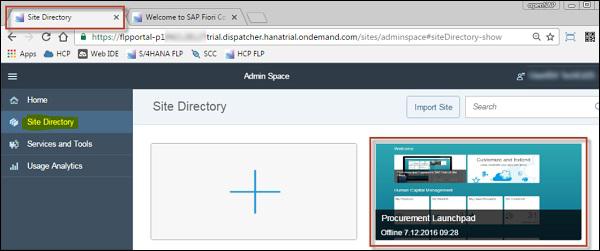
SAP Cloud Platform - New Site Creation
In SAP Cloud platform, you use Site Directory to create new site and to manage access to sites which you have permissions. Site Directory is first point for creating new sites. It is also possible to sort the cards in the Site Directory using the filter list (Sort-by) at the top, and you can search for specific sites using the Search field at the top right.
Using Site Directory, you can also view sites from additional sources, as follows −
Transferred Sites
Sites that were previously exported as ZIP files from other accounts or landscapes, and then imported to the Site Directory.
Transported Sites
Sites originated from a different account and deployed automatically to this account through SAP Cloud Platform.
To navigate to Site Directory, go to Services → Portal.
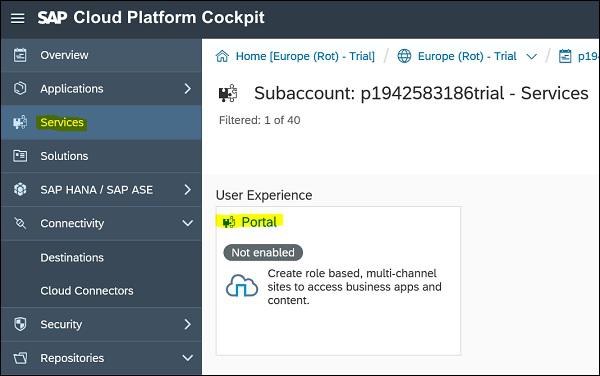
In the Overview tab of the Portal Section, you can see a short description of the service and a set of actions that can be performed. To access the launchpad(s) and the customization tool, navigate to go to Services
SAP Cloud Platform Portal lets you build digital experience portals for employees, customers, and partners. You can streamline access to business data so that your employees can execute their daily business tasks securely, from any device.
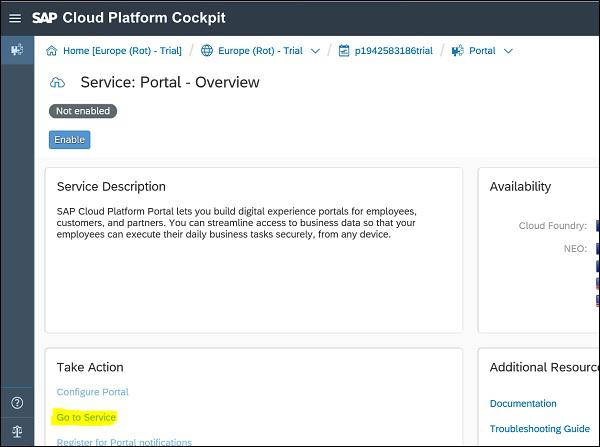
If you have already site defined, you can see list of all sites under Site directory page. To create a new site, click on card with cross button (+).
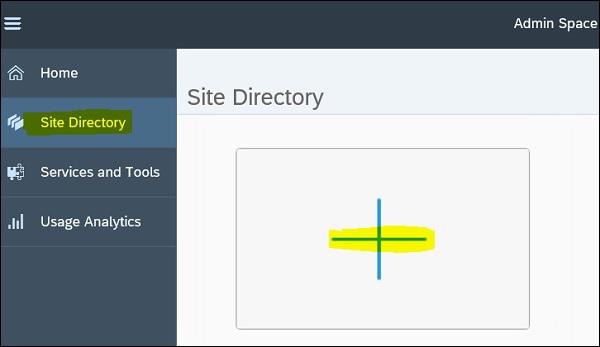
Next step is to enter a name and description for the site and click Create and Open. This will add site to Site Directory.
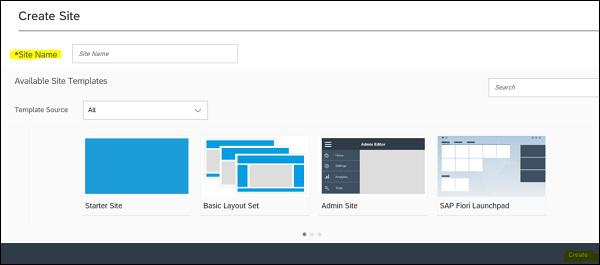
Using Site Directory, you can perform different tasks related to site management- import/export a site, publish a site, delete a site, etc. Following table lists different task you can perform using Site Directory → Site Actions
Create a new site |
Click +Add Site or click the blank card with the cross on it. |
In the Create Site dialog box, enter the Site Name and Description. Then click either Create and Open, or Save. |
Import an existing site |
Click  +Add Site +Add Site Import Site Import Site |
In the Import Site dialog box, browse to the location of the ZIP file, and Import |
Change the name and description of a site |
Hover over the card, click the next at the top, and enter your changes. |
The text is saved automatically. |
Open a site for editing |
Hover over the site card and click Edit |
The Authoring Space opens. |
Publish a site |
In the  (Site actions) menu, click Publish (Site actions) menu, click Publish |
This action makes the site available on the web, for viewing by end users. |
Take a site offline |
In the  (Site actions) menu, click Take Offline (Site actions) menu, click Take Offline |
This action does not delete the site, bur rather blocks end users access to it until you publish the site again. |
Export a site |
In the  (Site actions) menu, click Export. (Site actions) menu, click Export. |
This action creates a ZIP file of your site structure, contents, and optionally, a list of your site guests. |
Select a default site for the domain |
In the  (Site actions) menu, click Set as Default. (Site actions) menu, click Set as Default. |
A default site is indicated by a star in the top-right  Corner of the card: Corner of the card: |
Make an indentical copy of a site and its contents |
In the  (Site actions) menu, click Duplicate. (Site actions) menu, click Duplicate. |
In the Duplicate Site dialog box, enter a Name and optional Description for the site copy, and select whether to include the existing list of site guests. |
Delete a site |
In the  (Site actions) menu, click Delete (Site actions) menu, click Delete |
This action completely delets the site and its contents. You deleted and unpublished site or a site that has been takenn offline (You cannot delete a publish site.) |
Using Authoring space of SAP Cloud Platform, sites can be build, design and published. Authoring tools are used to make changes to site design, and changes are immediately implemented without need of saving work. You have following authoring tools from side panel to make changes to your site −
| Set your site-level settings such as: site URL, tracking code, and redirect for downtime or mobile access. |
 |
Site setting |
| View all content that is avaialble for use in your sites, and add it to site pages. |
 |
Content Catalog |
| Set the design settings for site, such as: site layout, site theme, and page template. |
 |
Design Settings |
| Add pages to your site and define specific settings for each page, such as: page alias, access level, and visibility. |
 |
Page Management |
| Add authors and invite site guests to view your site. |
 |
User Management |
| Preview your site on different devices. |
 |
Site Preview |
| Publish your site to make it available online, or take the site offline. |
 |
Publishing Options |
| Access the SAP Cloud Platform Portal documentation. |
 |
Help |
| Go back to the site Directory |
 |
Site Directory |
| Log off form the SAP Cloud Platform environment. |
 |
Log Off |

Note − For site creation, you should have TENANT_ADMINrole (Administrator) in the SAP Cloud Platform Portal cockpit.
SAP Cloud Platform - Site Design
After creating a new site, you need to design your site properly. When a site is created, it has only one page and you need to add sub-pages and define their hierarchy. You can also define different access levels for the site.
To define site structure, click Page Management in side panel → Page Management. This will open Page Management menu. You can also use Add Page button to add a page to your site.
To add an empty placeholder to the site menu (whose subpages are displayed upon hover), select Add Title from the dropdown menu and this will add a new page entry. You can also add a link to an internal or external page or site using “AddLink” from the dropdown menu.
You can also create a new page using content from another site page → Click “Import Page” from the dropdown menu. You need to select the site and the page you want to import → click Import. This will add a new page entry and shows the name of the source page.
You can also use Edit option at the bottom right or select the browser tab in Site Directory.
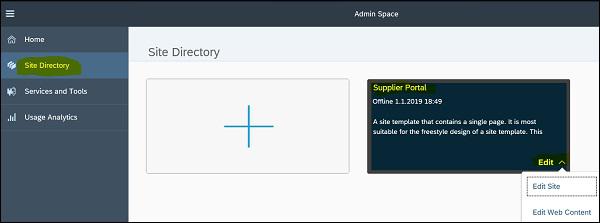
On the left side, you can access various tools, editors, and services provided by the configuration cockpit. To configure the Launchpad catalog open menu item, go to Content Management → Catalogs or click the Catalogs tile.
You can also navigate to Properties tab to edit name and description of application.


Using Roles tab, you can assign Roles tab and assign role to everyone.

SAP Cloud Platform - Site Themes
Using site themes, you can define overall appearance of your site. SAP Cloud platform offers predefined site themes and an administrator can add more themes to theme repository. In this chapter, let us see in detail the overall concepts involved in the site themes.
Themes used in site are defined in LESS stylesheet file - it is used to control UI part of site like font, color, etc.
To apply a theme, navigate to Design Settings → Services and Tools.
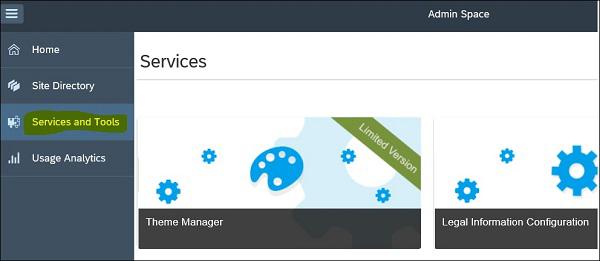
To assign custom theme to your site, navigate to Theme Manager. All the themes that you created are available under Theme manager. When you select a theme, you can check the following details under manage themes −
- Title
- ID
- Updated By
- Updated On
- Theme Upgrade
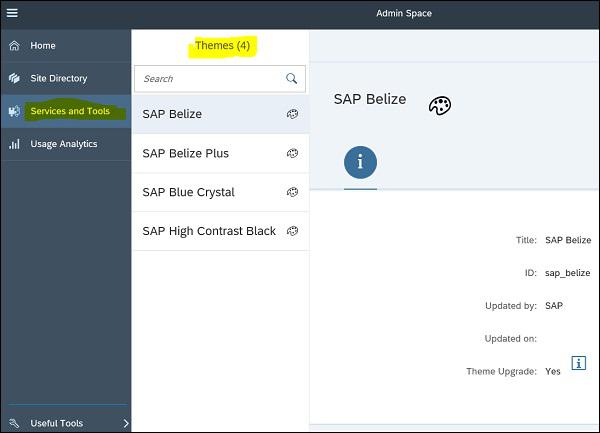
Bottom toolbar provides you following options to manage the theme. Click “Assign to Site” option to assign a theme to your site.
- Enable User selection
- Assign to Site
- Export
- Edit
- Delete
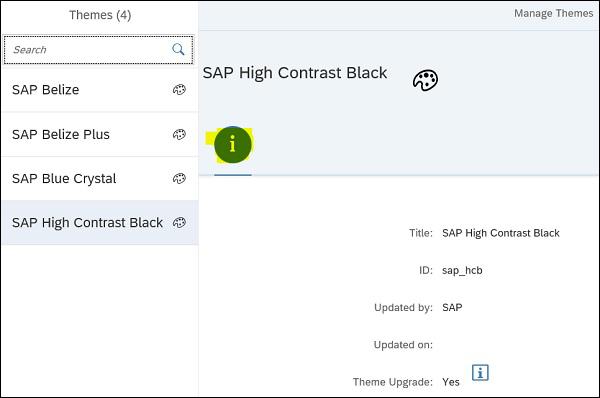
Once you apply all the changes, click Publish button to publish to your site.
Creating and Publishing Theme
To create a new theme, navigate to UI Theme Designer → “Create a New Theme” and select your base theme. You can select any of base theme from list of available themes.
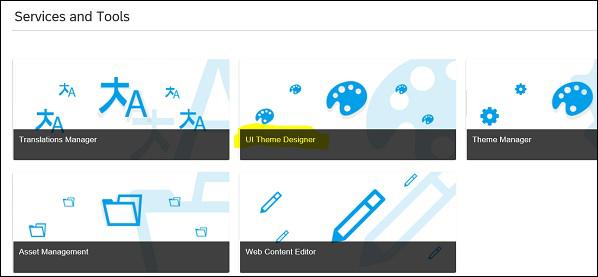

The following steps are involved while creating a customized theme −
- Choose Base Theme
- Name your Theme
- Set Options
In the next window, you must enter details under “Name your theme” - Theme ID and Title. You also have an option to define optional settings like Vendor, support, under Set Options.
To proceed with theme creation, click Create Theme.
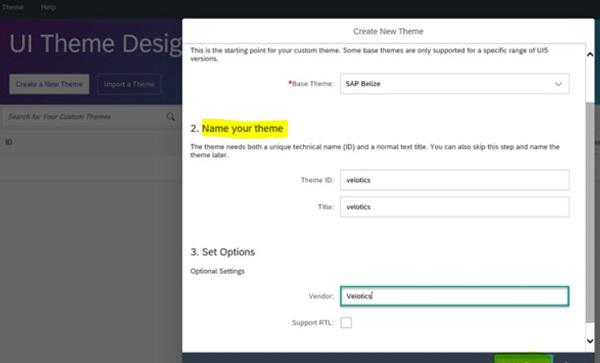
To customize a theme, first define a Target Page that will act as a canvas to perform changes. Use Quick Theming mode change color, image background, etc. and click Add button to add the target pages.
You can select from the following options on the right side −
- Quick Theming
- Expert Theming
- Defining Organization color
- Add LESS or CSS to your theme
On right side panel, you can select Quick Theming option by clicking the paint brush icon. You can change logo, add brand and base color for foreground and background.
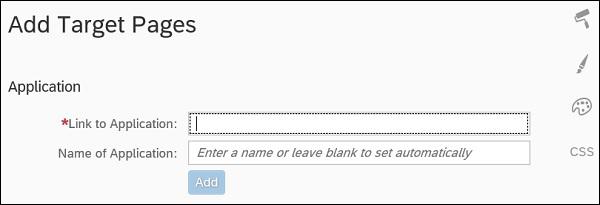
You can see below options under Quick theming. Select image you want to use for Company Logo → click OK to apply changes


Note that if you want to apply new theme to portal site, first step is to publish the theme using UI Theme Designer and apply the theme from Portal Theme Manager.

To Publish a theme, in UI Theme Designer top level menu → select Theme and then Save & Publish.
You can also validate the theme parameters that you defined while creating new theme- name, description, vendor, etc. Click on Save and Publish button as shown below to publish the theme.
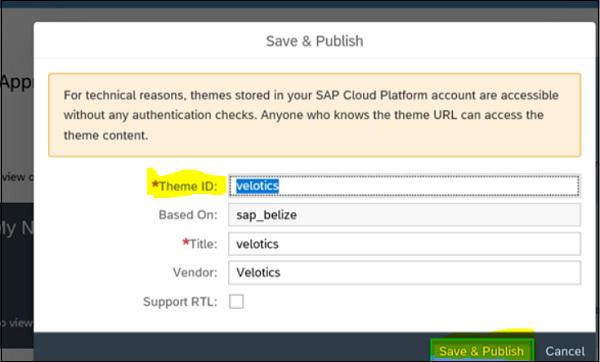
SAP Cloud Platform - Cloud Foundry Environment
While using Cloud Foundry environment, services are enabled by creating a service instance and bind the instance to application. You can create a Service instances based on specific service plan defined as configuration variant of a service.
To integrate any service of service instance with application, you need to pass service credentials to application. Achieving this, you can bind the service instances with application to automatically deliver these credentials to your application or other way is by using service keys to generate credentials to communicate directly with a service instance.

SAP Cloud Platform - Creating New Instance
You can create an instance using cockpit or command line cloud foundry interface. The first step for this is to navigate to space where you want to create a service instance. Navigate to Services → Service Marketplace
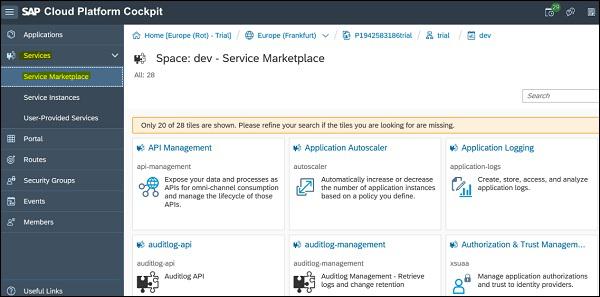
Now, select the service for which you want to create an instance → In the navigation area, choose Instances on left side → You can see an option to create New Instance.
You can also use search option to search for a service. When you use an enterprise account, you need to add quotas to the services you purchased in your subaccount before they appear in the service marketplace or it will only display services available in trial account.
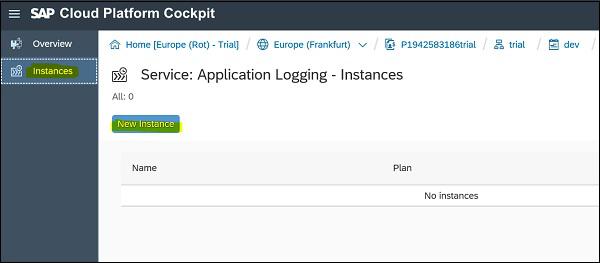
Select the service plan from the dropdown list → Next
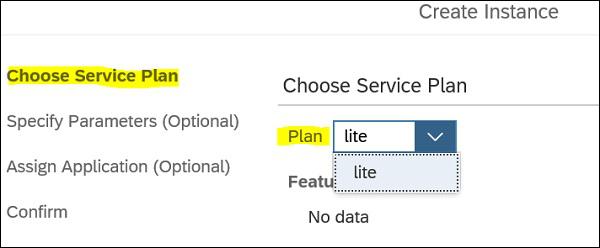
Next is to specify a JSON file or specify parameters in the JSON format →Next. This is an optional filed to select for instance creation and you can leave it blank and click Next.

You can also assign an application that you want to bind to the new service instance, choose it from the list and click Next. This is an optional field to select.

Enter the instance name and validate parameters passed during the instance creation. You can edit any of the parameter as required. Click Finish button to complete the instance creation.
To create a service instance using Cloud Foundry Command Line interface, you can run the following command −
cf create-service SERVICE PLAN SERVICE_INSTANCE
The following parameters should be defined in above command to create s service instance −
SERVICE − This shows the name of the service in market place to create an instance.
PLAN − This is the name of the service plan you want to use in instance creation.
SERVICE_INSTANCE − This is the name of the service instance. Note that you should use- alphanumeric characters, hyphens, and underscores.

Binding an Instance to Application
You can bind a service instance to an application using cockpit or command line interface. The binding of an instances to applications can be performed both at the application view or at service-instance view in Cloud cockpit.
To create a binding at service instance view, navigate to Services → Service Instances
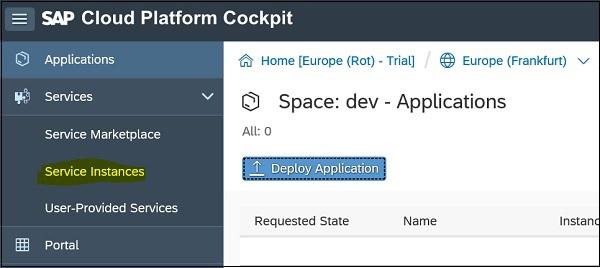
Select Bind Instance in the Actions column for your service instance as shown below.

Select your application from drop down and you can also specify parameters in the JSON format or select a JSON file → Save.

To bind a service instance to an application using Cloud Foundry command line interface, use the following command −
cf bind-service APP-NAME SERVICE_INSTANCE {-c PARAMETERS_AS_JSON}
In the above command, you have to pass the following parameters −
APP_NAME − You need to pass the application name.
SERVICE_INSTANCE − You need to pass the service instance.
-c − You need to pass service-specific configuration parameters in a valid JSON object (OPTIONAL)
SAP Cloud Platform - Creating Service Key
Service keys are used in an application to directly communicate with a service instance. When service keys are configured for service, apps from other space, outside entities can access your service using service keys. Service keys can be created using SAP Cloud cockpit or Cloud Foundry command line interface.
To create service keys using SAP Cloud cockpit, navigate to space where service instance has been created and go to Services → Service Marketplace

Select the service you want to create a service key → Select the Instance for which service key has to be created → Left side navigate to Service Keys tab.
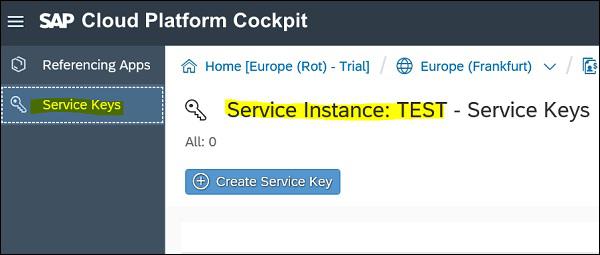
To create Service key for instance, click on Create Service Key button. Enter a name for the service key → Optionally enter configuration parameters → Save
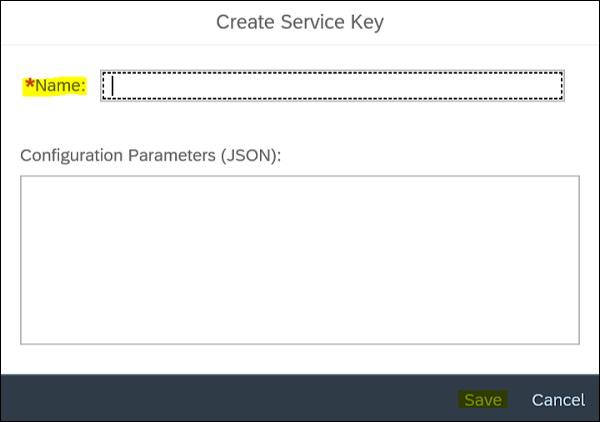
To create a service key using Cloud Foundry command line interface, you need to run the following command −
cf create-service-key SERVICE_INSTANCE SERVICE_KEY {-c PARAMETERS_AS_JSON}..
Now, enter the following parameters −
SERVICE_INSTANCE − This shows name of the service instance.
SERVICE_KEY − You need to mention the name for the service key.
-c − (Optional) Here you need to provide service-specific configuration parameters in a valid JSON object
SAP Cloud Platform - Publishing Site
When your site is finalized, you can publish it to make it available to others. Before publishing site, you need to ensure site displays as expected. Let us deal with this concept in detail in this chapter.
You will have to check the following points should be checked before publishing a site −
Previewing your site |
Before your publish your site, make sure that the site displays as your expect on every device that you need to support. It is much efficient to resolve any issue before your publish, rather than afterwards, when you would need to take your site offline to make any necessary changes. |
Editing the Site URL |
Before you publish your site, you can modify the suffix of the site URL to make it meaninful to your planned audience.
Choose a text string that includes the organization name, indicates the purpose of the site, and is as short as possible.
|
Publishing your site |
After you have previewed your site and made sure that everything is correct, you can publish the site to make it avaialble online. |

Publishing Options
The Publishing Options in the side panel change according to the site status: You have the following site status available −
Publishing Options – Offline
This shows that site has not yet been published or it has been offline after publishing for the maintenance.
Publishing Options – Published
This shows that site has published for other users.
Published Options – Modified
This shows that site has been published however it has been modified after it was published. Once the site has been published, you can invite others to access it by sharing a URL in an email. The public sites can be accessed without restriction; however private sites need invite to users.
In the following table, you can see the steps that need to be performed for publishing and updating a site −
Publish the site |
Make the site available on the Web for viewing by end users. |
Click Publish. |
View published site |
View the published site on the desktop or mobile device. |
|
Modify the published site |
Add and remove content to and from the site, and to change the design settings. These changes cannot be seen by end users until you publish the site again. |
Use the options on the side-panel menu to modify the site. |
Take the site offline |
Prevent end users form accessing the site. This action does not delete the site, but rather blocks access to it until you publish the site again. Site authors can still access the site. |
Click Take Offline. |
Cancel changes made to the site |
Remove all changes made to the site since it was last published. This option is not availble for site that have never been published. |
Click Revert to Last Published Site. |
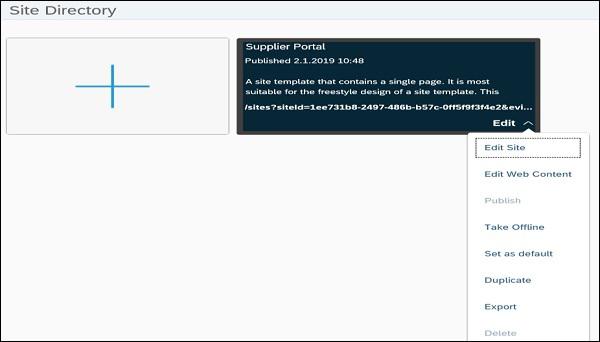
SAP Cloud Platform - Other Site Activities
You can define a site as the default site to your account. This helps user to modify a site without taking it offline for maintenance. You can make changes to the site and then make the updated site as default site for your account. In this chapter, let us discuss such other site activities that can be done.
To assign default site to your account, navigate to Site directory and bring the cursor on the site card you want to make as default. From Site Action menu → click Set as default.
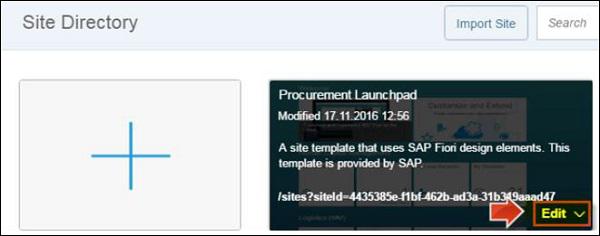
Managing Site Statistics
In SAP Cloud platform, you can also analyze statistics of portal sites which you have access. You can use Analytics dashboard to check statistical information related to Portal sites. Go to Analytics tab in Portal service to view charts or tables of statistical information about the usage of one or more selected sites.
You can use this information to better understand usage trends, and traffic peaks and lows, and thereby improve your sites to yield optimal results.
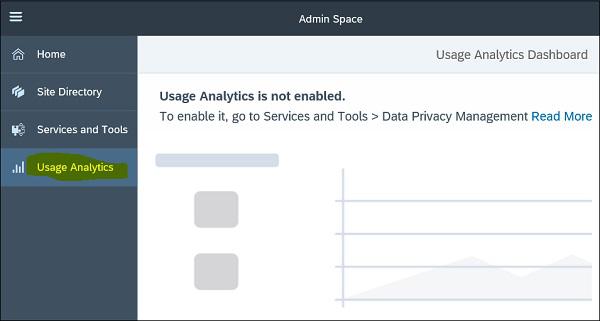
To enable it, navigate to Services and Tools → Data Privacy Management
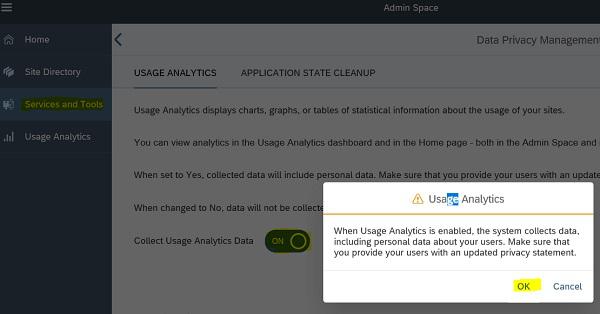
Using Analytics option, you can find the following information −
You can view a gauge for Visits and Visitors to measure the web traffic during a time period and you can further break the report in day, hours, and mins.
You can also view the different devices from which the site was accessed- mobile devices, tablets or user PC.
You can also check the information related to OS type used and browser types to access the site.
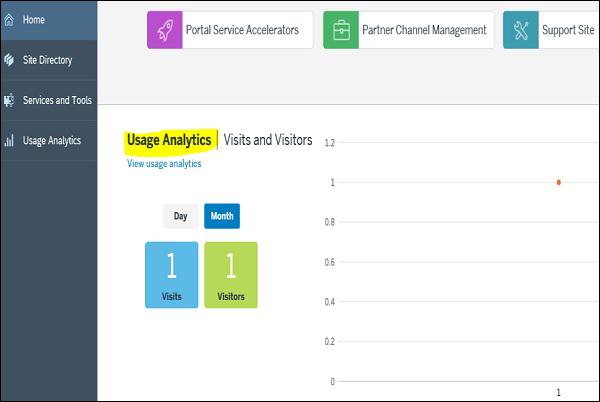
When you click View Usage Analytics, you have an option to Visits and Visitors details (Hour, day, week and month), device type, Operating systems and browser details.
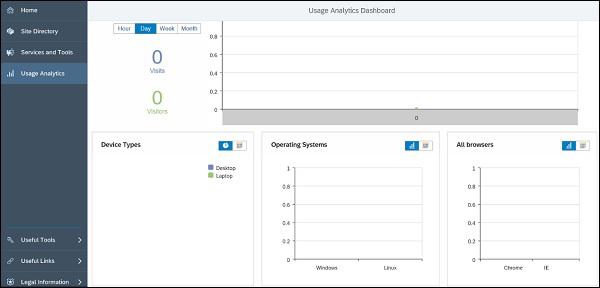
SAP Cloud Platform - Translating Site
You can also translate the site and download the content in PDF, HTML and other formats. Once the files are translated, you can load them to the site and users can view it in the browser language. However, note that the site is still maintained in master language.
When site is translated to other account, translations are automatically available in site content; however, when you duplicate a site using same account, translations are not available, and you need to export them and import the site to that account.
To define a site master language, you have to navigate to Site Settings menu. The site master language is also a fall back language when the selected language is not supported by browser.
Downloading Site Content
To download site content, navigate to Services and Tools and select Translation tiles in navigation pane → Configure option.
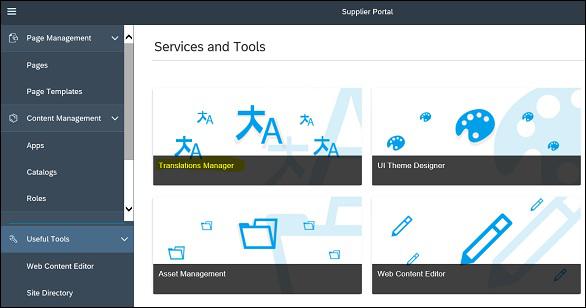
To download the master language of your portal site, click Download button as shown below. This will download the master language ZIP file onto your system.
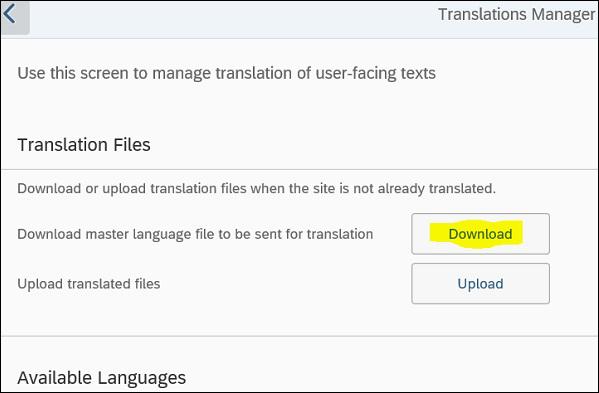
To translate this site into multiple languages, you can use SAP Translation hub service and the zip file which you have downloaded.

Go to UI for Translation workflow and create properties file for all the languages selected for translation. When translation is done, you can load the files into portal site.
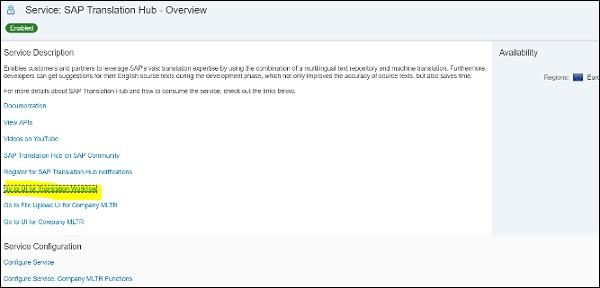
To upload, go to Translation tile → Configure → Upload
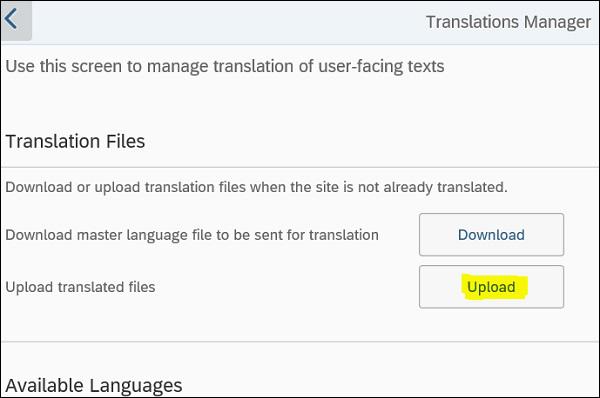
Now, browse for Zip file and open. This will process the zip files and all languages will be displayed on the screen. Note that all are inactive till you activate them. You can see the status of each language and to activate click “OFF” icon as shown below −

SAP Cloud Platform - Transferring Sites
You can also perform site transfer from SAP Cloud platform or to create a prototype or to create site from other accounts. Basic site transfer can be performed using export/import option in Site directory.
To export site as a zip file, it can include −
- Pages
- Content in Open Social widgets
- Theme files
- Translation sites
- Site user's details (Optional field)
To export a site, go to Site Directory → select the site to export and click on Site Actions → Export Site and save ZIP file to your system.
To import site, again go to Site Directory → Add site → Import Site.

This will create a site in the Site Directory and the transfer date is displayed in the Created field. You can also create a duplicate site, click on Site Actions → Duplicate Site.
Now enter the following in the name and description details −
- Site name of the new site
- Site Description of the new site
Next, click Duplicate button and this will create a copy of an existing site with name and description provided.
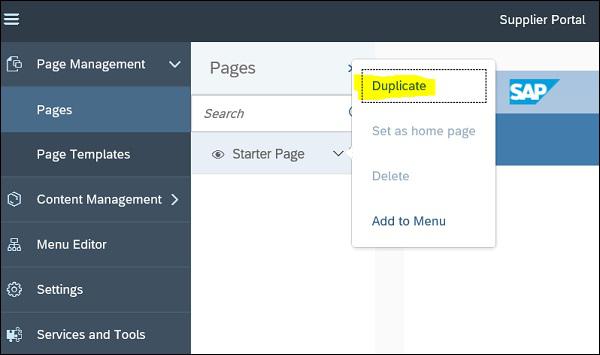
You can select “Include site users” checkbox if you want to include invited end users in the duplicated site.
Note − You should have “TENANT_ADMIN” role (Administrator) in the SAP Cloud Platform cockpit.
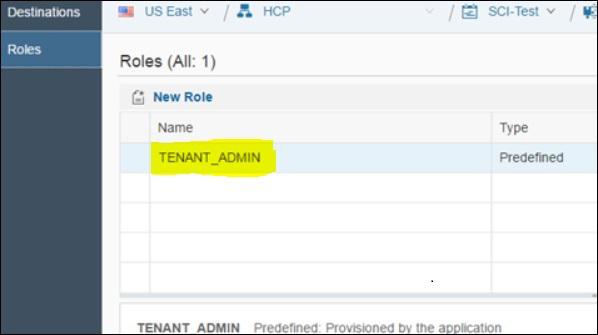
SAP Cloud Platform - Cloud Repositories
You can have different cloud repositories for site building maintained by SAP Cloud administrators. These repositories can be edited/modified by users with administrator privileges. The content of the cloud repositories is available in authoring space. In this chapter, let us discuss the available cloud repositories in SAP Cloud.
Types and Usage
The following repositories are available in SAP Cloud −
Theme Repository − This is available in Theme tab in Portal service
Document Repository − This is available on Document tab in Portal service
Widget Repository − This is available in Content tab in Portal service
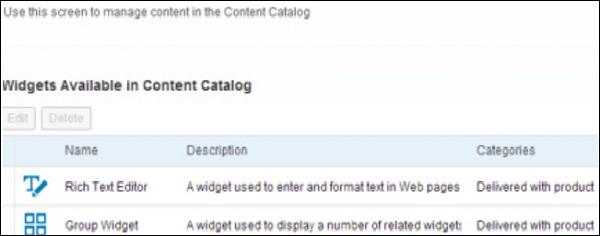
Using Theme Repository
In theme repository, themes are available in table form with details- name of the theme, description and theme creator name. Theme repository can be accessed from Themes tab of Portal service. The default theme for the account is represented using “star” shape symbol.
To create a new theme, navigate to Themes tab in the Portal service tab → Add Theme at the right corner and this will open “Add Theme” dialog box.
Enter the theme details, such as a name, description, and path to the theme file (LESS)location → Click Add button. You can also edit or delete an existing theme from repository.

Using Document Repository
Document repository contains all the documents which can be shared, reused in different sites. It contains all the documents for a given account. Document repository can be accessed from Document tab of Portal service in Cloud platform.
Documents can be uploaded and arranged in repository. You can also perform a search or download the documents and can also see site details where documents are used.
To access document repository, navigate to Portal service tab → SAP Cloud Platform cockpit → Repositories → Document Repositories
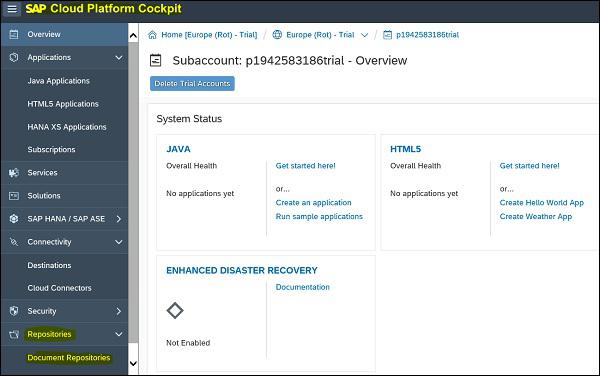
If document repository doesn’t exist, you can create a new Repository. Click on New Repository and enter the details −
- Name
- Display Name
- Description
- Description
- Repository Key
Note − Repository key should be minimum 10 characters.
Also, to maintain the content integrity in repository, you cannot edit documents stored in the repository. Instead, you download a document, edit it, and upload the new, updated document.
You can also edit repository name, change repository key or delete a document repository using below options −
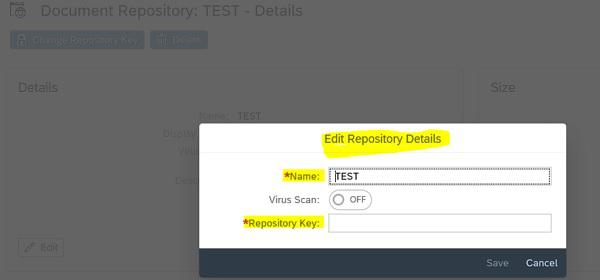
Using Widget Repository
Widget repository contains all the available widgets for a given account. You can access Widget repository from Content tab of Portal service in Cloud platform. The widget in repository are listed in table format and shows the basic information about widgets. Following Widget types can be added to repository −
- Social widget
- URL widget
- SAP Jam Feed widget
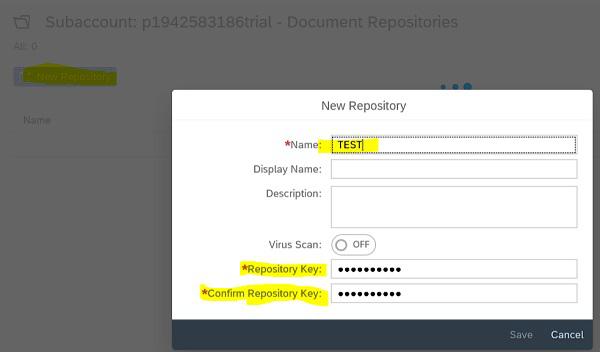
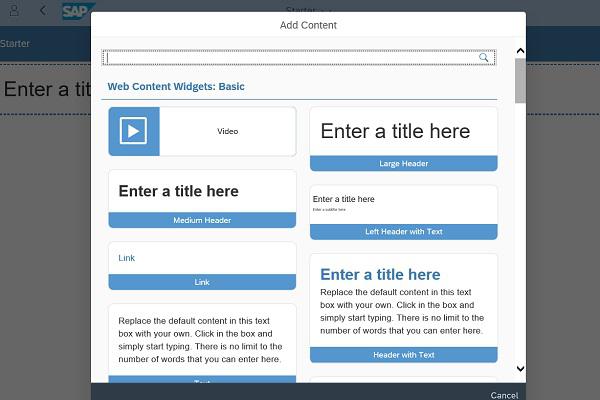
SAP Cloud Platform - Access Management
To manage and administrate sites, SAP Cloud platform provides different level of access and permissions. Administrators are responsible for managing content and themes of site and user level access is used to manage access related to site and published pages.
Roles
The following roles are commonly used in Cloud platform −
Administrator
This is predefined as Tenant_Admin in SAP Cloud platform cockpit. The administrator is used for adding and managing content and themes.
User Roles
This is used to manage access to published sites and pages. These are defined in SAP Cloud platform cockpit. Note that Authorization option is used to assign the roles to individual and user groups.
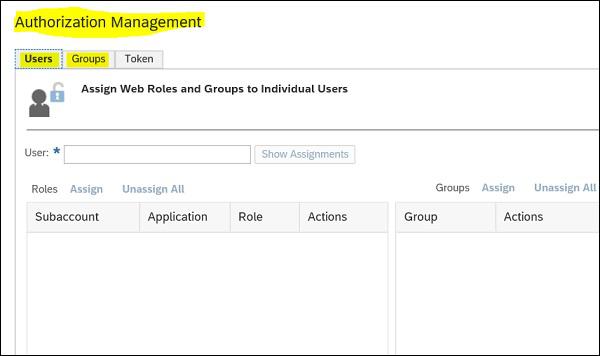
In Group tab, you can also create a new group and add users to it. To create a new group, click on New Group button and provide Group name as below −
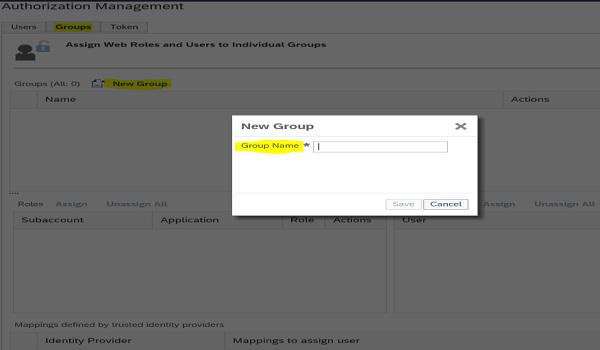
Guest Role
This role is used to allow access to individuals outside organizations for site access.
Managing Site and Page Access for Users
When you publish a site, you can allow different level of site access to users- public, authenticated or role based.
Public
When you allow public access to site, anyone on the web can access it.
Authenticated
This includes site users who are part of an organization and can access to site using predefined authentication mechanism.
Role Based
This includes only few users assigned with specific role can access the site.
Note − You can also limit page access permissions from Access Management panel on left side to manage access to site pages for one or more groups. Like site access, following access level can be granted for pages −
- Role - Based
- Public
- Guest
Go to Page settings → Page Authorization and you can see assigned access level to page. To make changes, click on Edit option on bottom right corner.
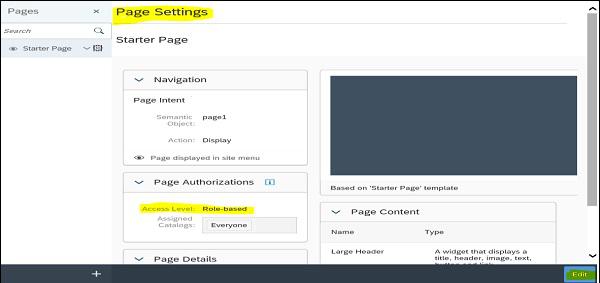
You can make changes to page access level using Access level drop down list from Page Authorizations. To save the changes, click on Save button.
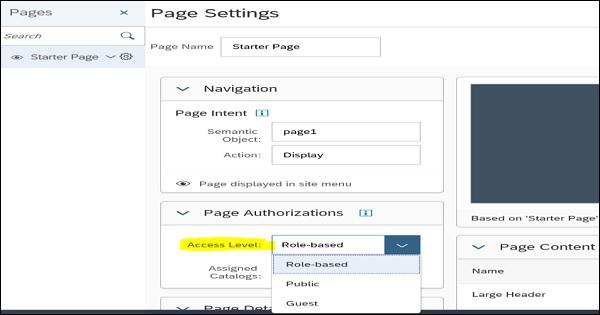
To create a new role, navigate to Roles tab under Content Management → New (+) icon at bottom.
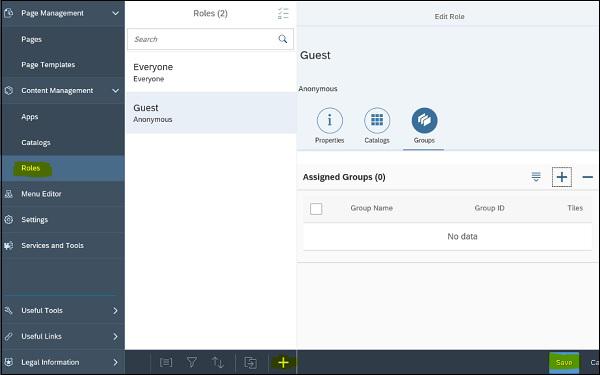
You have to define new Role properties like- Role Name and Role ID. Under Additional information, you can see Created, Creator and last modified date.
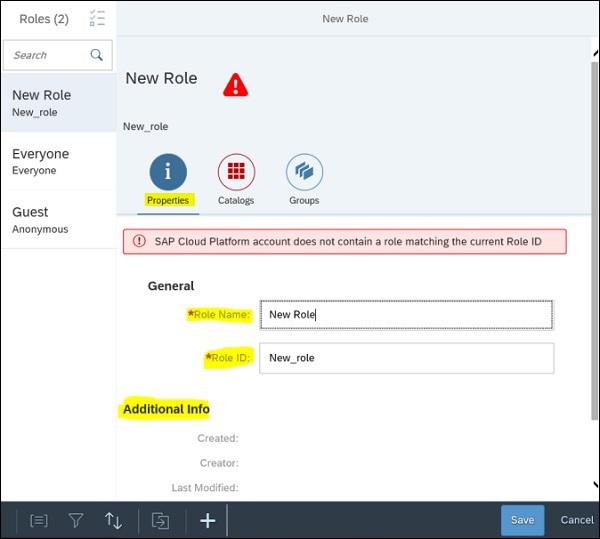
You can also assign more Catalogs and Groups to this role. Navigate to relevant tab and click on + sign to add new item. To save the changes, click on Save button.
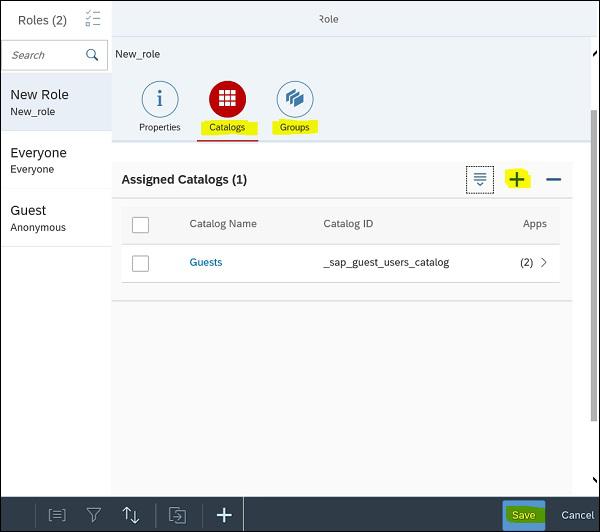
When you assign this role to any of Page, by default it takes the assigned Catalogs name as per role properties.

Managing Site Settings
You can also navigate to site setting options and edit different properties related to site- system, user and custom settings. Navigate to Settings tab on left side and this will open Site Setting menu. To make changes, click on Edit button at bottom right corner −
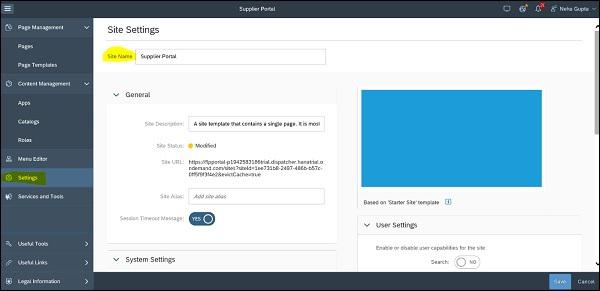
You can edit following System and User settings −
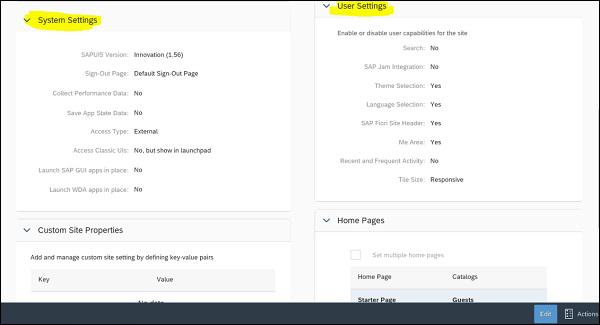
SAP Cloud Platform - Site Authors
Site author access can be provided to edit and maintain existing sites. It can allow users to open and edit all sites to which they have assigned access and this access can also be extended to other users. When an assignment is created for the user, it sends an email to new author with URL that allow that person to access and author new site.
To check Site URL, you can navigate to Site setting tab → General → Site URL.

Maintaining Profile for Login
You can also maintain your login profile as per requirement. Click the top right corner drop down → User information → Edit.
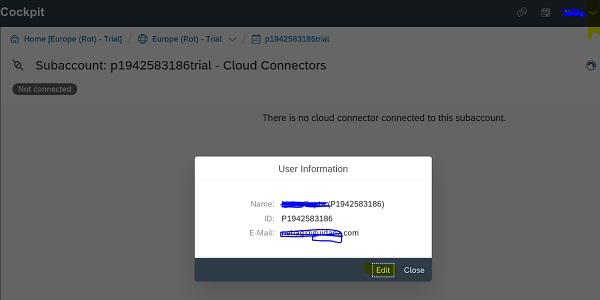
In User profile information, you can maintain the following information −
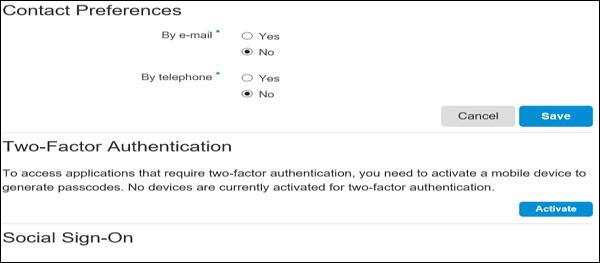
SAP Cloud Platform - HTML App Development
In SAP Cloud platform, you can develop SAP UI5, HTML5 based applications and open social widgets and consume them using SAP Cloud portal service. Using SAP Cloud platform, you can develop and execute HTML5 applications in cloud platform. It can contain static resources and can be connected to other on-premise or on-demand REST service.
To develop a HTML5 application and consume it in Cloud Portal service, you need to perform the following steps −
Develop HTML5 application and save it in HANA Cloud
Next is to convert HTML5 application to an OpenSocial widget
Add the OpenSocial widget to the Portal service widget repository
Setting Environment
To develop HTML5 applications, you can use the browser-based tool like SAP Web IDE that does not require any additional setup. Let us see how to develop “Hello World Application Using SAP Web IDE”.
Login to SAP Cloud Platform cockpit and click on Applications → HTML5 Applications. In case you have already created applications using this subaccount, it will show a list of HTML5 applications.
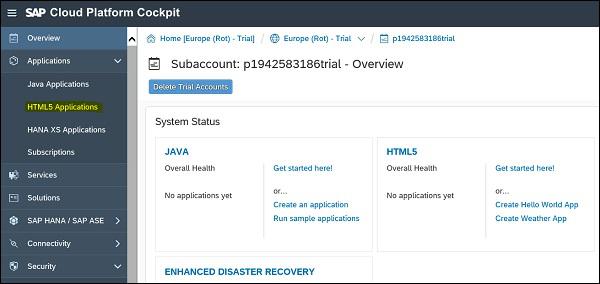
Now to develop a new HTML5 application → Click on New Application and enter an application name. Note that name of application must contain lower case alphanumeric characters and must not exceed 30 characters and start with a letter.
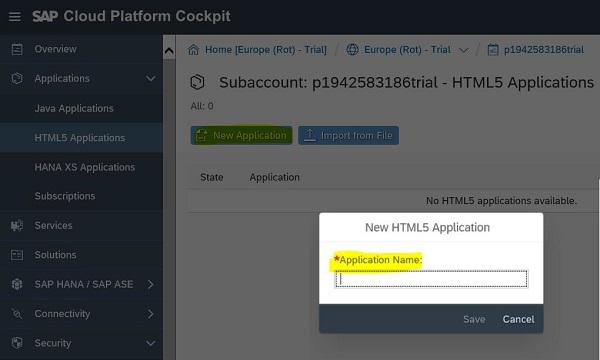
You can navigate to Applications page and click “Create Hello World App” to check the steps included in HTML5 development.
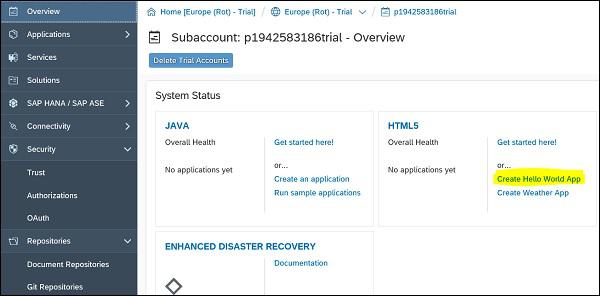
Steps Involved
The following steps are involved for creating a HTML5 application −
- Create a Project
- Edit HTML5 application
- Deploy the application to SAP Cloud platform
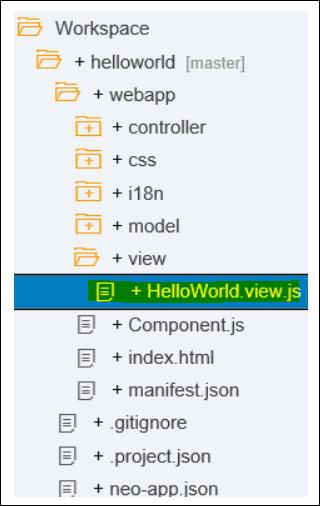
To deploy your application to SAP Cloud platform, right on application Deploy → Deploy to SAP Cloud platform.
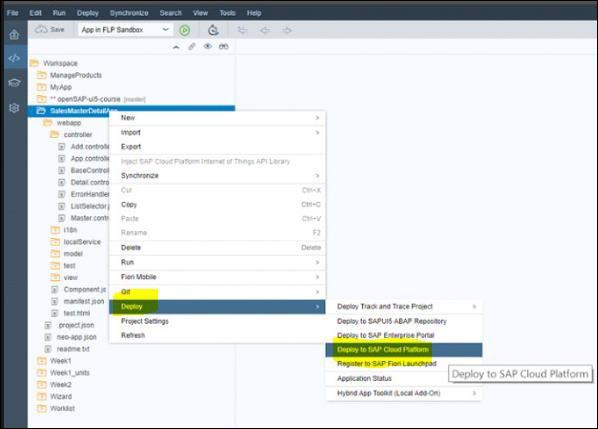
Login to SAP Cloud platform and enter user name and password. You can keep “Activate” option checked and this will activate new version directly.
Click OK button for completing deployment process.
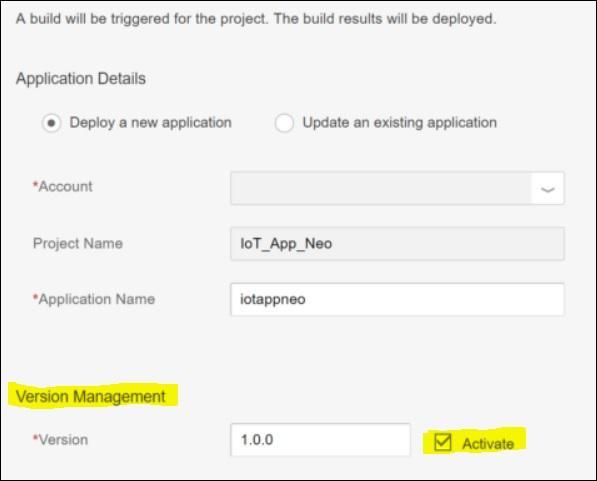
Backend System Connection
In SAP Cloud platform, objects in Portal site can be communicated to SAP Backend system. Portal service can be integrated with backend system like CRM, or SAP HR system. In this chapter, let us discuss them in detail.
Prerequisites
To integrate, following perquisites should be met −
You should have gateway server and service has been installed.
SAP Cloud connector should be installed, and connection should be defined between Gateway service and portal service.
You should have destination defined in portal service.
SAP Cloud Platform Connectivity option allows cloud application to connect internet service and on-premise system via Cloud Connector. SAP Cloud Administrator can create destinations so that users can build, test, and deploy applications. You configure the destination for SAP Web IDE to SAP Enterprise Portal in the SAP Cloud Platform cockpit.
For this purpose, navigate to Connectivity → Destinations and this will open destination editor. To create a new destination, click on New Destination option as below −
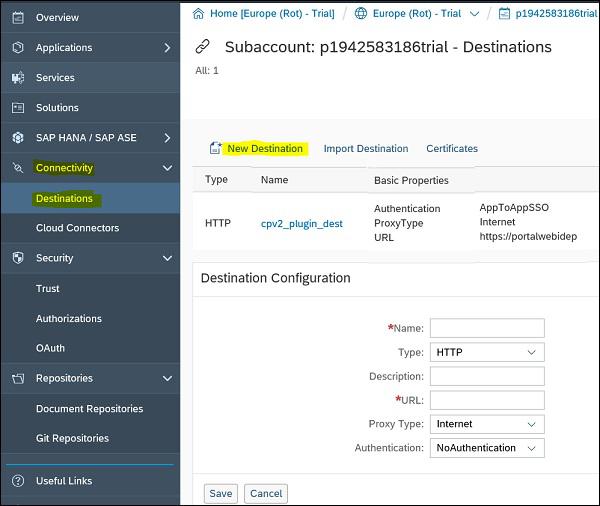
The following details should be entered to create a destination −
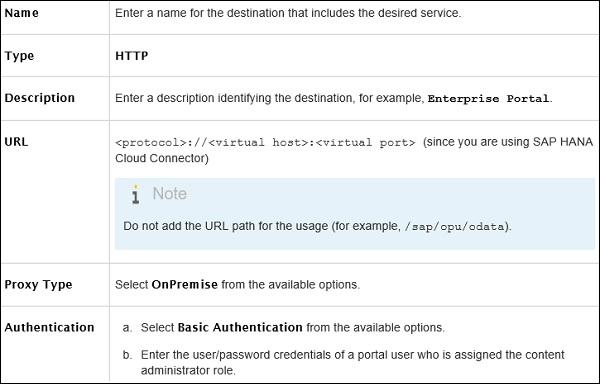
In the Additional Properties section, click New Property for each of the properties and click Save to save the destination.
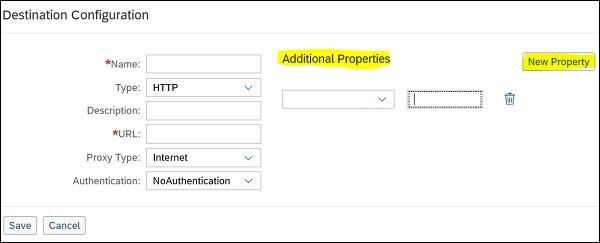
| WebIDEUage |
Type enterprise_portal |
| WebIDEEnabled |
Set the property to true. |
| WebIDESystem |
Enter your system ID. |
| ConnectionTimeout |
Enter the period of time in milliseconds that SAP Web IDE waits while establishing a connection before terminating the attempt and generating an error.
- Default: 10000(10 Secs)
- Max: value: 120000(120 secs)
|
| ClientReadTimeout |
Enter the period of time in milliseconds that SAP Web IDE waits for a response form the request service before terminating the attempt and generating an error.
- Default : 30000(30 secs)
- Max: value: 300000(300 secs)
|
You can also edit an existing destination by selecting Destination name and click on Edit button. You also have other options like - Clone, Export, Delete, etc.
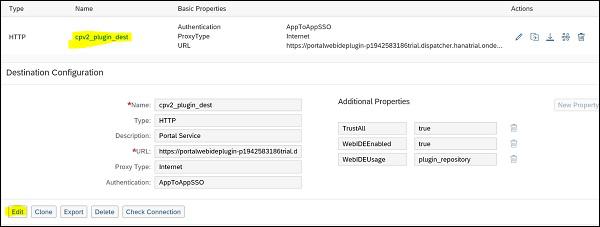
Trial Limitations
You can get a free SAP Cloud platform account with developer license to try and test the platform. This account can be used for non-productive usage and it only allows one member per account.
Besides, there are few other limitations in a trial account −

Subscription-based |

Consumption-based
|
Contract Period
Subscription period(typically 12 months or more).
|
Contract Period
Consumption period(12+ months).
|
Available SAP Cloud Platform Services
You can use the services that are specified in your contract. Additional service require contract modifications.
|
Available SAP Cloud Platform services
You are entitled to use all eligible SAP Cloud Platform services. No additional contract is required for changes in usage.
|
Price / Cost
The cost is fixed for the duration of the subscription period, irrespective of consumption.
|
Price / Cost
You prepay for cloud credits, which are then balanced against consumption of services.
|
Payment
In advance, at the start of the contract period.
|
Payment
In advance, and again when cloud credits are used up*.
|
Renewal
At the end of the subscription period.
|
Renewal
At the end of the consumption period.
|
SAP Cloud trial account does not offer a service level agreement related to availability of SAP Cloud platform service.
You cannot add any additional member to trial account.
Free trial provides 1GB of storage on shared HANA instance.
Trial version only supports Java and HTML5 application. It does not support HANA XS application development in trial account.
You can deploy multiple Java applications on your trial account however only one app can be in started state.
SAP Cloud Platform - Developer Responsibilities
SAP Cloud platform developer is responsible for the development and management of application on Cloud platform.
Primary responsibilities of SAP Cloud platform developer are below −
Developer is responsible for providing a reliable, scalable, extensible and secure infrastructure for application development and deployment on cloud platform.
Manage VMs, tools for setting up services on SAP Cloud Platform. Responsible for deploying and controlling the application development lifecycle.
Designing of new interfaces, wireframes and prototypes for new applications.
Designing new application with help of application designers.
It is preferred that developers have experience in following −
Exposure in configuring SAP Cloud Platform, Amazon Web Services, Azure, Google Cloud Platform.
Development experience in Web UI programming using JavaScript, HTML5, CSS.
Development experience using SAP UI5 application development methods.


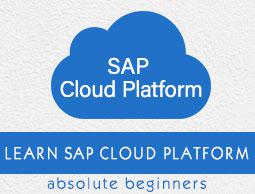












 +Add Site
+Add Site Import Site
Import Site
 (Site actions) menu, click Publish
(Site actions) menu, click Publish Corner of the card:
Corner of the card:

















































































